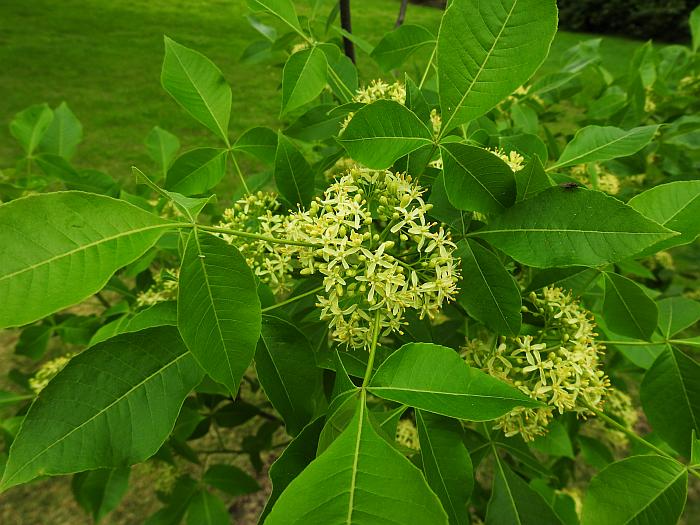Ptelea trifoliata L.
Common Hop Tree

Native
CC = 5
CW = 3
MOC = 64
© KBildner
Ptelea trifoliata L.Common Hop Tree | |
 |
Native CC = 5 CW = 3 MOC = 64 |
© KBildner |
|
Family - Rutaceae Habit - Shrub or small tree, usually 1-2 m, incompletely dioecious, usually producing at least a few perfect flowers. Stems - Branches ascending, the bark smooth or somewhat roughened, brown with prominent lenticels, occasionally developing a network of shallow, longitudinal ridges on large old trunks, unarmed, the twigs green, becoming brown, glabrous or sparsely pubescent with short, inconspicuous hairs, rarely densely hairy.
Leaves - Alternate, trifoliate, long-petiolate. Leaflets 2-15 cm long, the terminal leaflet longer than the lateral pair, ovate-elliptic, elliptic, rhombic, or oblong-ovate, the lateral pair somewhat oblique, angled or short-tapered to a sessile base, angled or tapered to a bluntly or sharply pointed tip, the margins minutely scalloped or toothed, the upper surface green, glabrous, the undersurface pale green, glabrous or sparsely hairy, mostly along the main veins, rarely densely hairy.
Inflorescences - Terminal, sometimes on short branches and thus appearing lateral, rounded panicles appearing as loose, branched clusters, the individual flowers long-stalked.
Flowers - Unisexual or less commonly perfect. Sepals 4 or 5, 1-2 mm long, ovate, minutely hairy, at least along the margins, not persistent at fruiting. Petals 4 or 5, 4-6 mm long, narrowly elliptic-ovate to narrowly oblong, usually minutely hairy, creamy white. Stamens 4 or 5 (reduced to 4 or 5 small staminodes in pistillate flowers), alternating with the petals, the filaments free, flattened, and densely hairy toward the base, attached to a lobed, glabrous nectar disc below the slightly elevated ovary base. Ovary 2-locular, flattened (reduced to a more or less conic rudiment in staminate flowers), glabrous, each locule with 2 ovules, rounded or short-tapered to a short, slender style, the stigma more or less 2-lobed.
Fruits - Samaras, 2.0-3.0 cm long, with a broad lateral wing, this circular to obovate-circular, papery, with a network of strong veins, short-tapered to cordate at the base, shallowly to deeply notched at the tip, the body 5-7 mm long, obovate to nearly circular in outline, flattened, with 2 locules, the outer layer hard, glabrous, strongly veined, pale green to straw-colored at maturity.
Flowering - April - June. Habitat - Limestone glades, prairies, forest openings, streambanks, pond margins, pastures. Nearly always on limestone soils. Origin - Native to the U.S. Lookalikes - Staphylea trifolia. Other info. - This shrubby species is common in much of Missouri, except for the northwestern quadrant of the state and the Mississippi Lowlands Division. It also occurs throughout most of the eastern half of the continental U.S., most commonly in a southwest-to-northeast band stretching from Oklahoma to Michigan. It is easily identified from its long-petiolate trifoliolate leaves and small flowers, which are commonly found with both four and five petals within the same inflorescence. The plant is most commonly found on calcareous glades. Photographs taken at Alley Spring, MO., 5-22-03 (DETenaglia); also at Weldon Spring Conservation Area, St. Charles County, MO, 5-11-2010, Shaw Nature Reserve, Franklin County, MO, 5-21-2015 and 5-20-2022, Danville Conservation Area, Montgomery County, MO, 5-15-2018, and Klondike County Park, St. Charles County, MO, 6-11-2022 (SRTurner), and in Lemay, St. Louis County, MO, 5-19-2020 (K. Bildner). |